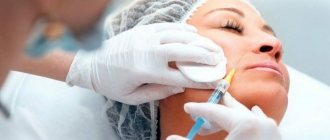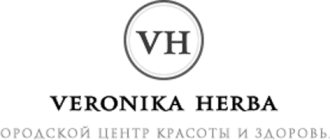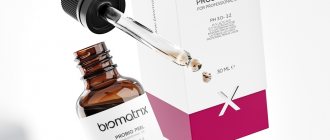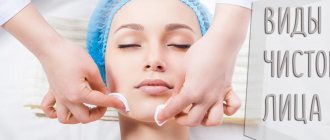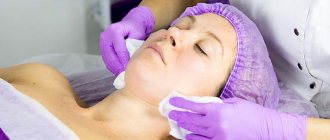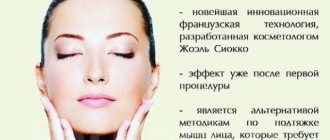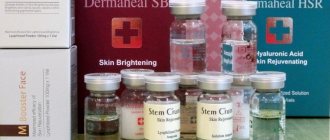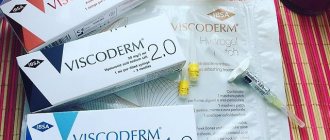Indications and contraindications for facial mesotherapy
The content of the article
Main indications for use of the procedure:
- early aging of facial skin;
- the appearance of wrinkles;
- slight sagging of the skin;
- the appearance of furrows;
- obvious dark circles under the eyes;
- the appearance of pigment spots;
- pronounced “spider veins”;
- the presence of surgical scars and scars.
Quite often, this procedure is resorted to before facial plastic surgery, as well as as rehabilitation procedures after the operation itself. Sometimes the method can be used in conjunction with other cosmetological techniques. Experts advise combining mesotherapy with peeling and laser resurfacing, the effect will be incomparable.
Contraindications:
- poor blood clotting;
- inflammatory processes on the skin;
- chronic infections;
- pregnancy, lactation;
- increased body temperature;
- heart problems;
- urolithiasis disease;
- drug intolerance.
Before performing the procedure, it is imperative to consult with a specialist so that there are no consequences.
After mesotherapy, the face becomes smoother, the skin acquires elasticity, visible wrinkles are smoothed out, vascular networks, and dark circles under the eyes disappear.
General recommendations after facial mesotherapy
The rules for skin care after injections are simple and do not require significant costs. Widespread Chlorhexidine will need to be applied to the treated area daily (once a day). To protect against external irritants (primarily direct sunlight), use sunscreen with a high protection index. Finally, medicinal gels (such as Bepanten, or the well-known Panthenol) are used to speed up healing. If there are visual defects caused by injections (hematomas or bruises), it is recommended to use regular Troxevasin ointment.
At the same time, we must not forget about the presence of possible contraindications, so a preliminary consultation with a specialist (especially if you have allergies) would be a reasonable option.
Hyaluronic facial mesotherapy
This is facial mesotherapy with hyaluronic acid. Hyaluronic acid is actively used in medicine. It is injected as a biological substance under the skin and after some time provides results.
Mesotherapy using hyaluronic acid is painless, it is considered safe for health, and there are no side effects. The procedure is suitable for any skin; it uses hyaluronic acid of both plant and animal origin.
The main advantage of this procedure is its complex effect on the entire facial skin. The effect will be noticeable after the first session. To fully achieve the effect, it will take about 9 sessions. The results will last for several months, and in some cases for several years.
Medicines used in mesotherapy
The success of a cosmetic procedure depends not only on the technical skills of the performer, but also on the competent selection of ingredients for a healing cocktail. Cosmetologists have at their disposal a whole range of medicines used in mesotherapy. They can be divided into two groups:
- traditional pharmacopeias: hophytol, procaine, trental, piroxi-cam, ribomunil, myacalcic, dicinone;
- specific for mesotherapy: lipodystrophin, Achyal, triac, embryoblast, X-ADN.
When selecting medications, the doctor proceeds from the indications for their use. At the same time, he is guided not only by the traditional grounds for carrying out the procedure, established during more than half a century of experience in mesotherapy, but also by new indications discovered in recent years.
The drugs used - both primary and auxiliary - should not cause addiction or rejection by the body. It should be borne in mind that in hypersensitive people a number of components can lead to undesirable consequences. The sulfurous acid salt, which acts as an antioxidant stabilizer, can cause an allergic reaction. Someone may develop an intolerance to parabens used as preservatives. Propylene glycol, which is part of injectable drugs, can also produce a toxic effect when administered intradermally.
In the world practice of aesthetic mesotherapy, there are two approaches to the selection of drugs for injection. Italian experts insist on the use of ready-made mono-medicines or multi-drug preparations prepared in special biotechnological laboratories. French doctors advocate a personal approach to patients, based on the compilation of arbitrary prescriptions for injection cocktails.
The second option requires more experience and knowledge from the doctor. After all, an erroneous combination of medications can cause drug incompatibility of a chemical or physical nature. Moreover, one drug can not only neutralize another, but also cause its action to have the opposite effect.
Fractional facial mesotherapy
This is micro-piercing of certain areas of the skin. The depth of penetration of the active substance directly depends on the size of the skin area, as well as on the individual thickness of the skin. Over time, smooth, young tissue appears at the puncture site.
After the first three sessions, the first effect becomes more noticeable; after five, the damaged areas of facial skin are completely regenerated. After mesotherapy of this type, slight swelling may appear, which is caused by individual sensitivity to the active substances of the medicinal drug. After the procedure, it is prohibited to apply any cosmetics to the face.
Indications for mesotherapy
The wide range of applications of microinjections includes:
- decreased skin tone;
- age-related skin aging, wrinkles;
- cellulite;
- acne;
- oily skin with enlarged pores;
- rosacea;
- baldness;
- scarring;
- stretch marks;
- pigmentation;
- excess fat deposits;
- restoration of the skin after insolation, surgical interventions, laser thermolysis, peeling.
Preparations for facial mesotherapy
The facial mesotherapy procedure can be carried out with the following drugs:
- hyaluronic acid (activates the growth of new collagen fibers);
- silicon and magnesium salts (increase elasticity and tone of the skin, normalize cell nutrition);
- phospholipids (a substance that is part of cell membranes that provides elasticity).
In addition, various antioxidants, vitamins, enzymes and other biologically beneficial substances can be used.
The doctor selects cocktails for facial mesotherapy individually for each patient, depending on the course of the disease and diagnosis. A cosmetologist makes cocktails from several components, and sometimes uses ready-made preparations. Based on the composition, cocktails can be homeopathic or allopathic. Allopathic cocktails are the most popular; homeopathy is used less frequently.
Mesotherapy technologies. Injection technique for mesotherapy
In modern cosmetology, several types of effects on the dermis are used. Classic mesoinjections remain in demand - the injection of drugs to a depth calculated depending on the indications. This technology complies with all the canons developed by Pistor.
Recently, new effective techniques have emerged that allow deviations from classical execution:
- mesopuncture – superficial impact on acupuncture points;
- mesoinfiltration - the use of injections to penetrate the deep layers of the dermis;
- mesoperfusion – a single-use hardware administration of a medicinal cocktail in doses equal to several Lebel needles;
- non-invasive mesotherapy – achieving an effect without injections by treating problem areas with electrical impulses.
A professional cosmetologist knows several mesotherapy techniques that require a certain “hand positioning”. Among them are:
- nappage – performing a series of frequent microinjections, the volume of each of which does not exceed 0.02 mg;
- papular technique - the creation of papules (skin swellings) of various diameters to speed up the deposition of injected drugs;
- linear technique - injection into a canal formed in the dermis; Depending on its shape, there are such linear modifications as fan, tracer, tunnel and mesh (reinforcement).
There are manual and hardware mesotherapy. The first is more valuable, as it has the advantages of an individual approach, allows you to penetrate the most delicate areas and use medications sparingly.
It is advisable to use automatic injectors when treating large areas of skin. They make the procedure less painful, speed up its progress and make the doctor’s work easier. However, expensive equipment increases the cost of hardware manipulations.
Possible complications after mesotherapy
Complications during mesotherapy should not be confused with the undesirable consequences that accompany most drug procedures. The latter include:
- the appearance of redness in the injection area, which normally goes away within 25 minutes after the meso-session,
- the occurrence of hematomas - an inevitable payment for “beauty injections” that damage the walls of blood vessels;
- moderate pain associated not only with errors in the mesotherapy technique, but also with the individual characteristics of the patient, in particular a high sensitivity threshold.
Complications aggravating the procedure are considered to be:
- infectious and necrotic manifestations on the skin caused by errors of medical personnel: neglect of antiseptic requirements, incorrect selection of drugs or method of their administration, use of medications of dubious origin, inability to handle instruments or equipment;
- allergic reactions - in the form of swelling of the face, itchy blisters or hives - associated with incorrect selection of drugs that are incompatible with the patient’s body.
Careful diagnosis of the patient will help to exclude complications of mesotherapy. If a history of predisposition to allergies is identified, an allergy test is performed on the contents of the injections. To avoid excesses, on the eve of the session the consumption of alcohol and vasodilating medications is excluded.
Much depends on the professionalism of the cosmetologist and the level of the institution in which the procedure is performed. Although severe consequences are rare with mesotherapy, the patient should worry about providing conditions for emergency care.
Advantages of mesotherapy
- The stability and brightness of the effect, which lasts for 6-12 months.
- Safety: the drugs used have physiological characteristics, which is important in unfavorable environmental conditions.
- Versatility: the procedure is indicated at any age, starting from 18 years; the list of contraindications is kept to a minimum.
- The low-traumatic nature of the procedure ensures its relative painlessness.
- No need for long rehabilitation.
The consequences of mesotherapy are nonspecific
- Pain - with any damage to the skin, pain receptors are irritated, so there may be a pain reaction of varying severity. Its strength depends on individual pain sensitivity, the pH of the injected drug, the area of therapy, and the quality of the needle. Some patients tolerate the procedure quite calmly without pain relief, which is better for the subsequent effect of mesotherapy, according to the doctrine of the mechanism of action. For the category of particularly sensitive people and simply for psychological peace, you can offer local pain-relieving ointments such as “Emla”. But we must remember that the ointment begins its analgesic effect 20 minutes after application, and maximum pain relief will occur only an hour after applying the ointment. So, arrive early for your procedure to really get the maximum pain relief.
- I have already written that the least painful is the administration of hyaluronic acid preparations, and the most painful are vitamins and DMAE. This is due to the pH of the drug, if it is much lower or higher than pH 7.2-7.4, then pain will always be felt when such a drug is administered. Both the diameter of the needle and its sharpness matter. Therefore, during the procedure, it is recommended to change needles more often, they quickly become dull, and, if possible, choose thinner ones. If we talk about the site of injection of the drug, the most sensitive are the back and inner thighs, the nasolabial fold and the middle area of the face.
- Redness at the injection site is a completely normal reaction associated with the vascular reaction to the injection. It usually goes away on its own within 15-30 minutes; in smokers it lasts longer - up to 45 minutes.
- You can quickly relieve this reaction by applying a special soothing mask after mesotherapy. The mask must be sterile, specially packaged and intended only as a mask after mesotherapy. Cream soothing masks should not be applied immediately after the procedure.
- Swelling will also always be a response of the skin to the injected drug and to injury. It depends on the drug administered, for example, after the administration of hyaluronic acid and other gels, the swelling is more pronounced, since these drugs themselves attract water. Swelling may persist for a day and goes away on its own.
- Hemorrhages - a wide variety, from a pinpoint reaction to a needle prick to hematomas - occur with deep administration of the drug, with increased fragility of blood vessels, with a decrease in blood clotting in the patient.
- Unfortunately, it is not possible to completely guarantee that the vessel will not be damaged and there will be no “bruising”. The risk of developing hematomas increases during menstruation, when applying anesthetic ointment, when taking certain medications, such as aspirin, preparations based on ginkgo biloba, green tea, vitamin E. Their use should be stopped the day before the procedure. When administering solid preparations, the risk of hemorrhage is also higher than when administering aqueous solutions.
- What to do if a hemorrhage occurs? Press the bleeding site with your finger, apply cold, use absorbent ointments - “Traumel”, heparin, troxevasin, “Bruise-off”, other masks based on bodyaga, Arnica ointment. It is better to limit yourself to Arnica ointment and Traumeel, because thistle causes peeling of the skin, acting as a peeling.
- Vagal syndrome - what is it? Sometimes, as a response to pain, cold extremities, dizziness, and decreased blood pressure occur - these symptoms are associated with irritation of the vagus nerve and are stopped by the administration of a special drug.
Mesotherapy effect
“Beauty injections,” as therapeutic cocktails of antioxidants, vitamins, microelements, enzymes, and amino acids are often called, stimulate the natural metabolic processes of the skin. As a result, collagen and elastin begin to be more actively produced, preventing the appearance of wrinkles, pigment spots and other aesthetic imperfections disappear.
Mesotherapy is an effective remedy for cellulite. After the treatment course, the skin texture returns to its former smoothness. The presence of lipolytic drugs in injections does not leave a chance for excess fat cells. Their destruction does not lead to the concentration of fat in other places, which is often observed as a result of liposuction.
The delicate nature of mesotherapy allows it to be used in combination with other cosmetic procedures. So, to achieve maximum anti-cellulite effect, it is recommended to first undergo lymphatic drainage massage. After its effect on problem areas, you can proceed to mesotherapy. It is advisable to consolidate the resulting effect with wraps and vacuum massage.
The consequences of mesotherapy are specific
- An allergic reaction to the administered drug is rare, more often with the administration of vitamins (especially C) and multicomponent cocktails. The reaction may not appear on the first day, but on 2-3 days after the procedure. It is expressed in redness of the skin, the appearance of vesicles and blisters like urticaria. Sometimes such a reaction may occur not to a mesotherapy drug, but to an anesthetic ointment.
- An immediate allergic reaction - anaphylactic shock - develops immediately after the procedure, sometimes even during it. There is pronounced tissue swelling, redness, itching, and blisters. In severe cases, a general reaction of the entire body develops, requiring emergency medical measures.
- Infectious complications are very rare and may be associated with the characteristics of the patient’s immune system, with non-compliance with aseptic rules when performing the procedure (including by clients).
- When some drugs are introduced into the deep layers of the skin (deeper than 4 mm), necrosis of the surrounding tissue may develop - most often this happens when drugs are administered to break down fat (phosphatidylcholine). Infectious complications are treated with antibiotics or by a surgeon.
How to reduce the risk of complications after mesotherapy?
- First of all, choosing a clinic and doctor to perform this procedure. I insist on having a higher medical education, it is advisable to have a specialization in dermatology and cosmetology, the doctor must constantly improve his qualifications - after all, cosmetology today is developing very quickly and new techniques are appearing all the time. Ask your cosmetologist if he has a diploma!
- I categorically do not recommend performing such mesotherapy at home - if complications develop, you will not prove anything to anyone!
- The doctor should carefully ask you about possible allergic reactions to medications and the presence of certain diseases that are a contraindication to the procedure.
- But you, too, should not forget about your contraindications and point out to the doctor possible allergic reactions, if suddenly the doctor forgot to ask you about it. There is no need to be shy and silent, this will only harm yourself!
- The doctor purchases medications for mesotherapy in special training centers; before purchasing them, he undergoes additional training in working with this particular drug.
- Mesotherapy preparations are NOT SOLD in pharmacies, are not purchased online, and will not be sold to untrained people. If these rules are violated, it means that “not all is well” in this institution, and there is no guarantee of the quality of the purchased product.
- And also in the case of purchasing drugs, for example, via the Internet and by the patient independently, there is no guarantee that someone will be responsible for possible undesirable consequences. Choose for yourself - save a little on the drug or still carry out a high-quality procedure!
The consequences of mesotherapy and complications, however, are RARE, so there is no need to be afraid of this effective and necessary procedure.
Just don’t place all the responsibility for carrying out mesotherapy on the doctor and the clinic, think for yourself, “use your head!”, take an interest in the drugs that are administered to you, the administration method, do not remain silent like a partisan during torture and you will feel GOOD!)))
Mesolifting – rejuvenating mesotherapy
The author of mesolifting, an injection method for tightening facial skin, is the Parisian cosmetologist Bernard Herzog. Achieving a visible lifting effect occurs due to the launch of skin restoration mechanisms, returning it to youthful elasticity and freshness.
This anti-aging procedure is considered one of the most effective non-surgical ways to combat a double chin and facial deformation. A rejuvenating course, consisting of 5-15 weekly procedures, completely replaces plastic surgery.
Beauty and youth during mesolifting are returned to the patient by a series of microinjections introduced into pronounced facial wrinkles and neck folds. Withered skin is saturated with the vitamins, microelements and amino acids it lacks. A noticeable result can be observed after the end of the 5th session. The patient's face looks rested and refreshed, regaining its previous contours and healthy color.
